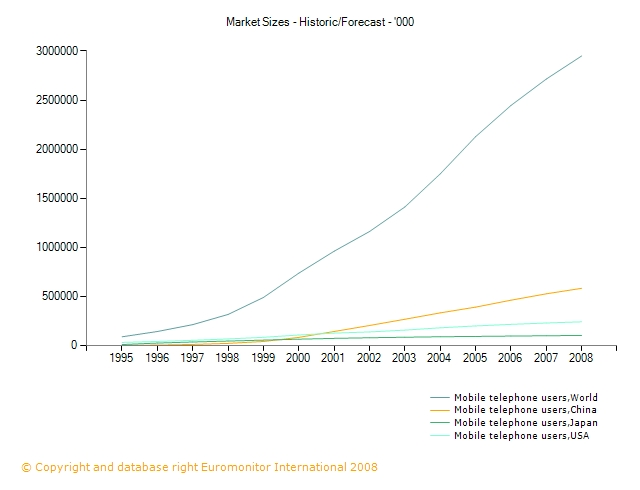In the modern world where getting “connected” means more than being a novelty because it’s already a necessity, cellular phones have become a “must-have” gadget to virtually everyone in the world. Whether in Japan, China, or the United States, people from all walks of life deem it necessary to have a cellular phone for business or even for personal use. In 1995, only 90 million people all over the world were using mobile phones. In 2008, however, the number of mobile phone users around the world is projected to reach almost 3 billion users, with China as the most lucrative market that will have 585 million cellphone users (See Figure 1).

In the research for the demographical differences for the substantial usage of technology in China, Japan, and the United States, it will be necessary to ask the question: “what are the driving forces that entice the market for cellular phones in these countries and what is the effect of people in these countries if they own more cell phones than other?” A cellular phone has become widely popular because of its portable capabilities, which enable instant access and communication abilities. For example, Leung and Wei (2000) researched an empirical Hong Kong-based study on the uses and gratifications of cell phone usage.
Their findings indicate that while features available from the regular telephone (such as sociability and instrumentality) are also desirable in mobile phones, the most important motives for owning a cell phone were linked to the device’s unique features of mobility and portability, which alleviate the need for public phones and also allow for immediate access to others. Robbins and Turner (2002) conducted a similar study in the U.S. context, and contend that while segments of the population will likely resist owning a cell phone, there is still a larger group that falls in the category of the people that have the potential to adopt the technology later.
Although manufacturers are wooing consumers with a continuous stream of additional capabilities and content, according to a survey by J.D. Power and Associates, mobile phone style is the leading buying factor, with 40% of respondents making it the single most popular reason for selecting a particular handset. Cheapness was the next most popular criterion with 27% saying they chose their phone because it was free.
Sony Ericsson is regarded as proof that style sells because it ranked highest with 741 points in the survey (J.D. Power Associates, 15 November 2007). Euromonitor International (2008) also reported that the level of mobile telephone ownership in China dwarfed the rest of the world, with some 600 million users in 2008, more than the next four largest users – USA, Japan, Russia, and Germany – combined. Mobile telephone user rankings and penetration are said to be relevant to consumer behavior, mobile entertainment, and the teen segment of the country’s economy. In this research, these factors will be discussed and how the subsequent addition of capabilities and content to mobile phones has created an ongoing consumer behavioral shift as more and more activities encompassing business and pleasure become possible.
The continuing developments in the cellular phone markets mean that communication, business, and entertainment are on the move and in remote locations makes mobile phones the most dynamic consumer indicators of the early 21st century in terms of consumer lifestyle, product sales, and content sales. If we know the demographic trends and the driving factors of owning a cellular phone in China, Japan, and United States, marketing for mobile phones in these countries would be much easier to make and it would determine what business strategies are possible to further increase mobile phone population in the world.
References
Euromonitor International. (2008). Mobile Phone Market in the World. London: Global Marketing Information Database.
J.D. Power Associates. (2007). Feature-Rich Wireless Mobile Phones Increase Average Consumer Service Spending For Both Handset Manufacturers and Service Providers. Web.
Leung, L. and Wei, R. (2000). More than just talk on the move: Uses and gratifications of the cellular phone. Journalism and Mass Communication Quarterly, 77, 308- 320.
Robbins, K. and Turner, M.A. (2002). United States: Popular, pragmatic and problematic. In Katz, J.E. and Aakhus, M. (eds). Perpetual Contact: Mobile Communication, Private Talk, Public Performance. (pp.80-93). Cambridge: Cambridge University Press.